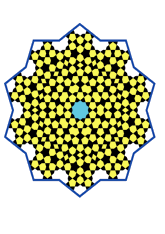Charbagh Madrasah, Isfahan
 data197/IRAN3
(Click on image for high-quality PDF version)
data197/IRAN3
(Click on image for high-quality PDF version)
Star taken from a two-level pattern, see Madar-i Shah Madrasah.
Geometry
- The symmetry group of the tiling is *10.0• (d10.0).
- All the internal angles of the constituent polygons are a multiple of 36°.
- Contains two regular two-pointed star polygons with vertex angle of 72°.
- Contains 6 regular pentagons.
- Contains two regular five-pointed star polygons with vertex angle of 72°.
- Contains three regular 10-pointed star polygons with vertex angle of 108°.
- There are 6 non-regular reflective tiles.
- The tiling is edge-to-edge.
- As drawn, contains about 461 polygons.
References
Publications referenced:
- Vol1, Page 158 (Charbagh Madrasah, Isfahan, Iran) of Mahmood Maher al-Naqsh. Design and execution of drawing in Iranian tilework, Islamic period, Reza Abbasi Museum, 1983. [iran] {Good collection of Iranian patterns, text in Persian} Available on Internet.(1122AD, 515AH)
- Fig A.31 of Brian Wichmann and David Wade. Islamic Design: a Mathematical Approach, Springer, 2017. ISBN 978-3-319-69. [ww] {}
- Vol1, Page 81 (Location not given) of Mahmood Maher al-Naqsh. Design and execution of drawing in Iranian tilework, Islamic period, Reza Abbasi Museum, 1983. [iran] {Good collection of Iranian patterns, text in Persian} Available on Internet.
v54

